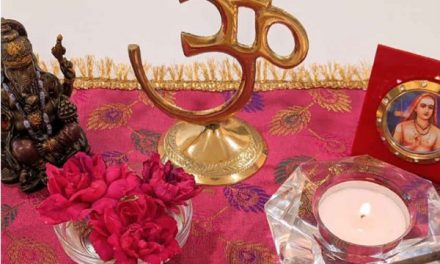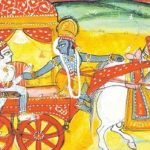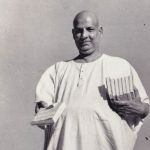 Bhakti Yoga
Bhakti Yoga
The Surest way to God
by Swami Swaroopananda
Introduction: The Nature of Bhakti
Bhakti is devotion to God. Its nature is intense love towards God, the Beloved or towards the Guru. It is of the nature of Divine attachment. It is a type of attachment that does not bind but liberates, because it is attachment to God, and God is within us.
God is not an external object to which we get attached. Rather, He is our own Self, our Innermost Reality. Bhakti is real, it is powerful, and it is of the nature of Bliss. Yet, it is also of the nature of pain, as one of its modes is experiencing the pangs of separation from the beloved. This is a sweet, divine pain that is considered the highest form of Bhakti.
 Bhakti Yoga is a very potent system of yoga. Its centerpiece is extraordinary intense love that is directed towards God and is experienced by the practitioner. Bhakti is primarily generated by purification of the heart and the mind through the practice of Karma yoga or selfless service to our fellow beings. This purification leads to meditation, and through meditation our mind becomes steady and one-pointed. Once the mind is pure, steady and onepointed, we can meditate on Iswara, the Lord.
Bhakti Yoga is a very potent system of yoga. Its centerpiece is extraordinary intense love that is directed towards God and is experienced by the practitioner. Bhakti is primarily generated by purification of the heart and the mind through the practice of Karma yoga or selfless service to our fellow beings. This purification leads to meditation, and through meditation our mind becomes steady and one-pointed. Once the mind is pure, steady and onepointed, we can meditate on Iswara, the Lord.
Through this meditation we come to a point where we experience the Reality of Iswara. When we experience the reality of Iswara, Bhakti emerges. In the practice of Bhakti Yoga, the aspirant becomes the lover and Iswara becomes the beloved. Eventually, through this process of love, the lover and the beloved become one. Bhakti is this process of union through love. Grace is a main principle in the path of Bhakti yoga because everything that we receive in this path comes from Grace.
One of the best ways to attain this Grace is satsanga, or association with saints. Bhakti Yoga is a path of service – service of saints, service of the Guru and service of our fellow beings. Through this service, blessings and Grace are invoked and the result is Divine Love. Bhakti Yoga is a very beautiful yoga; it purifies the mind of its impurities and gives birth to the yoga of knowledge or Jnana yoga, which removes ignorance and leads to Moksha or spiritual liberation.
Who is God?
Bhakti is Supreme, one-pointed devotion directed towards Iswara, or God. According to the yogic scriptures, Iswara is the One that includes within Himself the All. In the Eleventh Chapter of the Bhagavad Gita, Lord Krishna shows to Arjuna His Cosmic Form. Within this Cosmic Form Arjuna sees everything – all universes, all creations, all beings, all kingdoms of nature – past, present, and future – all included in that one Being. Iswara is the Absolute Reality in a process of manifestation.
Within Him are the cosmic processes of creation, preservation and the dissolution of creation. In His essence, Iswara is Brahman – pure consciousness, all-pervading, transcendent, infinite life, existence, love and bliss. One can meditate on Iswara as the totality of everything that exists. But those who are unable to do this, meditate on Him in one of His aspects as Divine Father, Divine Mother, Divine Child, etc. When we meditate on Iswara and repeat His name the result of this meditation is Bhakti or Divine Love.
Love is the great attractor; it is that thing which attracts us to search and to find our Essential Nature.
What is Love?
Love is a Divine attribute; it is of the nature of immortality, it is of the nature of Ananda or absolute Divine Bliss, it is ecstatic by nature, it is the Divine essence that permeates pure awareness or pure consciousness. Love is the Ground of all Being, the Ground of Existence, it is that thing which keeps everything together, it is the force that is responsible for creation, preservation and dissolution of creation. Love is identical to the Atman or Self, as it is identical to Iswara or God. It is inexpressible, but it can be experienced.
Love is the power that destroys duality, because it is a force through which the two become one. Love is the great attractor; it is that thing which attracts us to search and to find our Essential Nature. Love is irresistible; when we hear its call, we cannot resist it and we are attracted to the source of this call of love until we merge in it so the two become one – the lover and the beloved unite. Love is contagious; when a person is in a state of divine love or divine ecstasy, those who are in his or her presence enter a similar state because of their association with that Bhakta or lover of God.
Love spreads very fast, it is allpowerful, it can overcome everything; it can overcome darkness and all negative traits. It is the key for meditation; without it we cannot truly meditate. We breathe it, we eat it, we are made of it, it sustains us, it unites us, it shows us the truth of Unity in Diversity, we merge in it and in the end, it destroys us in the highest sense.
Love and Non-Attachment
Vairagya or non-attachment is an important principle in the path of yoga. Does this mean that we should be indifferent and non-loving? To the contrary. When we are attached to objects or people, there can be no real love. Vairagya means ‘acting without selfish desires.’ When we truly love, ultimately, we want nothing for ourselves, only for the other. When we reach that selfless state, we become free. Vairagya means freedom from desires which are based on egoistic motivation. It means acting out of love, desiring nothing for ourselves, not even appreciation.
The joy is just in serving and loving the other. In the Narada Bhakti Sutra Narada Muni says: “Bhakti is its own fruit”. When you have Love, you have the highest reward. What else can you want? When we experience Love, all our desires are immediately fulfilled, we have everything. To be non-attached does not mean to be indifferent. Precisely because we are not attached, all our will is dedicated to giving, loving, embracing humanity, and sacrificing our entire life for others. If we want nothing for ourselves, we are rich.
The easiest way to find love is to stop thinking about ourselves and to focus on the needs of others, as Mother Theresa said: “Service is love in action.” It is a mistake to equate love with attachment. The nature of love is bliss; the nature of attachment is suffering and pain. The things to which we are attached by nature change and pass away. We also change and pass away. If I am attached to chocolate, with time, my teeth may go bad and even my capacity to taste, smell and see the chocolate may diminish. Or I may get diabetes and the chocolate will become a source of pain and destruction for me.
Once the heart and the mind are purified, love will manifest. It is not a matter of belief. It is a matter of direct experience.
Similarly, if I am attached to a person, this will also bring suffering because both myself and the person to whom I am attached constantly change and eventually will pass away in one way or another. Before you go to sleep tonight, make a list of all your attachments, then meditate on this list and ask yourself, “how many more attachments would I like to have?” One attachment is one shackle; two attachments are two shackles; a thousand attachments are a thousand shackles. Do we really want to be slaves to our attachments?
We can be attached to alcohol, to people, to food or to money. These are all kinds of addictions, and addictions bring pain and suffering. Love is the exact opposite. By its very nature it is full of bliss, joy and freedom. Love frees us from bondage and therefore yogis believe in love and practice Bhakti Yoga – the yoga of love. Some people find it difficult to love, but if they practice, love will come. Once the heart and the mind are purified, love will manifest. It is not a matter of belief. It is a matter of direct experience.
Cultivating a Relationship with God
People relate to God in many ways. Some relate to the Divine in an abstract way, without name and form while others relate to the Divine in a personal form. There are people who do not believe in God, but they believe in the Atman or Self. Some are skeptics or atheists, but even they believe in something. They believe in truth, in that which cannot be denied. If God is truth, then the skeptics and even the atheists believe in God.
When the Dalai Lama was asked if he believed in God, he replied: “some people say that God is love. If God is love, then I believe in God”. There are many other ways to relate to God. We can relate to God as Divine Father, Divine Mother, Divine Child, etc. The way in which we relate to the Divine is called our Ishta Devata or chosen deity. How do we cultivate our relationships with God or the Ishta Devata? It is just like in any other relationship. When two people are in a relationship and they wish to cultivate it, the first thing they need to do is to spend time with each other.
Similarly, when you have a relationship with God you need to spend time with God. How do we spend time with God? We do this through meditation or through devotional practices. We can pray to God, talk with God, meditate on God, quarrel with God, etc. The most important thing is to spend time together with our beloved. When you really love someone, you cannot stop thinking about your beloved. When you cannot stop thinking about God, this is called meditation.
According to Swami Sivananda, meditation that stops when you raise up from your seat is not real meditation. Real meditation goes on when you sit, walk, lie down, eat and so on, because when you have a real loving relationship with the Divine, whatever you do, you cannot stop thinking about your beloved. When you speak to little children about falling in love they do not understand, but if you speak to them about playing with toys, they do understand.
Similarly, to beginners on the path we have to say: ‘wake up in the morning, go to the satsang hall, meditate for half an hour, chant, do yoga asanas, etc.’ This is like playing with toys. Beginners need these reminders because they are not mature enough to understand the meaning of love. But when we mature, we fall in love with God. Then we need no reminders because all we want to do is to meditate and to be in the presence of our beloved; we have an intimate relationship with God and we know what it is, nobody needs to tell us.
How to Love Unconditionally
As we grow from selfish love to selfless love, as the mind and the heart become purer, our love becomes unconditional. Unconditional love does not expect anything in return; it exists only for the sake of the beloved.
In the beginning, it manifests as selfless service to our fellow beings. From service to our fellow beings, we develop love for our fellow beings and at some point, this love turns into Bhakti – an inconceivable love towards God. Thus, Karma Yoga is the best method to attain unconditional love. Loving our fellow beings leads to love of God because God is all.
In the 11th chapter of the Bhagavad Gita, Arjuna sees All in the One. The One includes everyone – not only the good and the beautiful but also the terrible and the most despicable. Thus, Bhakti, which is love of God, is directed towards the All; it embraces all. As the heart purifies through selfless service, the heart grows and grows until it can contain the Lord, until it can contain the All.
Bhakti is unconditional love. People ask how can we love unconditionally? The answer is, we first need to love conditionally. We begin with selfish egoistic human love and gradually this love extinguishes our ego and matures into unconditional love.
To love unconditionally means not to put conditions on our love. To say, ‘I will love you only if you love me’ does not make sense. It is like saying ‘I will breathe only if you breathe’. We do not put conditions on our breathing, we simply breathe. But Love is more essential than breathing. Love is the foun – dation of our existence. When we understand this, we love unconditionally.
Bhakti Yoga Sadhana
There are nine modes in the ladder of Bhakti Yoga. These are nine practices that are mentioned in the Puranas and prescribe the sadhana of Bhakti Yoga from the simple to the more difficult practiced. Those nine modes are Sravanam (hearing of God’s Lilas and stories), Kirtanam (singing of His glories), Smaranam (remembrance of His Name and presence), Padasevanam (service of His feet), Archanam (worship of God), Vandanam (prostration to the Lord), Dasyam (cultivating the Bhava of a servant with God), Sakhyam (cultivation of the friend-Bhava) and Atmanivedanam (complete surrender of the self).
The first mode, Sravanam, is listening to stories about God. Hearing stories about the beloved invokes love in the heart. If you hear stories about Swami Vishnudevananda, eventually you develop devotion towards Swami Vishnudevananda. If you hear stories about Lord Krishna, devotion towards Lord Krishna is invoked. Sravanam is the practice of hearing stories that are told by bhaktas, by devotees of God. The transmission of Bhakti is direct. It happens from the heart of the Bhakta to the heart of the student. Sravanam is to sit at the feet of bhaktas, saints, and devotees of God and listen to their stories of the Lord. This invokes Bhakti within the heart.
The second mode of Bhakti Yoga is Kirtanam – singing the divine names and glories. Kirtan is a very powerful devotional practice. Everyone loves music and chanting, it is universal, and it penetrates places where the intellect cannot reach. It penetrates the deepest layers of the subconscious mind and takes the aspirant to the Innermost Reality or the Self. Therefore, since time immemorial Kirtan has been 18 Bhakti is unconditional love. People ask how can we love unconditionally? The answer is, we first need to love conditionally. We begin with selfish egoistic human love and gradually this love extinguishes our ego and matures into unconditional love. one of the most important spiritual practices.
The third mode of Bhakti Yoga is Smaranam, constant remembrance of God. One of the best ways to practice Smaranam is Japa – repetition of the mantra or God’s name. By practicing japa, the mind of the practitioner becomes one with the mantra, which according to the yogic scriptures, is nothing but God Himself. God and His name are one and the same. A mantra is a powerful divine energy in a sound structure. It causes the mind to unite with God, with the Ultimate Reality that resides within our heart.

Swami Sivananda practicing Japa with mala beads
One can attain Self-realization through the practice of japa alone. According to Swami Sivananda, while doing japa, the practitioner should also practice dhyana or meditation on the meaning of the mantra, which is the Lord Himself. For example, if you meditate on the mantra of Lord Krishna, you should also meditate on His form and divine qualities. Japa should be practiced with devotion, but it is also a method to cultivate devotion. When you love a person and you think about their name, this brings to mind the memory of that person and that memory awakens love.
Similarly, repeating God’s name leads to the remembrance of God and that remembrance awakens Bhakti or love of God, which in turn leads to unity with God. In his book Bliss Divine, Swami Sivananda writes: “live in love, breathe in love, sing in love… die in love”. What does it mean to “die in love”? It means that in the end, you are totally consumed by that love and nothing is left from you, only the beloved exists. Love is compared to fire. When you throw something into the fire, it is consumed by the fire and nothing remains but the fire.
Similarly, when you practice the yoga of love, at the end nothing remains but love, nothing remains but bliss. Even if the repetition of the mantra is mechanical in the beginning, it will eventually generate devotion. By repeating the mantra, you release this divine power and once it is released, it manifests devotion. Then there is Bhava, a loving relationship between the one that repeats the Divine Name and the one that carries the Divine name. Japa is a very powerful method because God and His name are one. When you repeat His name, even if you are not aware of it, you are instantaneously in His presence.
Constant repetition of the mantra leads to darshan – a direct vision of the Divine. You will experience the Divine within your heart. You will also experience Him outside of you. Then your life will be changed for the better, forever. ‘As you think so you become’ – if you think about God and repeat His name, you become one with God. Chanting the Divine Name is said to be the easiest way to realize God in this Kali Yuga or iron age. Repeating the Divine Name leads to the highest levels of meditation.
The other modes in the ladder of Bhakti Yoga are Padasevanam (service at the Lord’s feet), Archanam (Worship of God), Vandanam (Prostration to the Lord), Dasyam (feeling of being a servant of God), Sakhyam (feeling friendship towards the Lord). At the top of that ladder is Atmanivedanam – total self-surrender to God. Along with these nine modes of Bhakti, there are also five Bhavas or devotional attitudes. Those are Santa Bhava, the peaceful attitude; Dasya Bhava, relating to God as a loving servant to a loving master; Sakhya Bhava, regarding God as your friend, Vatsalya Bhava, regarding God to be your child, and Madhurya Bhava, relating to God as the beloved.
Atmanivedanam: Self-Surrender to God
The highest practice in the ladder of Bhakti Yoga is Atmani – vedanam or self-surrender to God. The yogi surrenders completely the self or ego in the ocean of love, which is God. It is compared to a drop of water that touches the ocean and becomes one with the ocean. This is a state of union, of nonduality. The path of love starts with duality and ends with non-duality. When the devotee becomes one with the beloved then he or she are in a state of non-duality within a state of love.
The meaning of surrender is to recognise that we are not separate, that nothing exists in isolation, that everything is connected to everything else within a ground of Pure Consciousness. The Universal Pure Consciousness, which I am, is the Reality upon which the universe of names and forms is superimposed. To that Universal Consciousness, to whom we call God or the Self, I surrender. God and the Self are one and the same. Swami Sivananda says that God is closer to you than your jugular vein, because He is your own existence.
I exist because God is existence, I am conscious because God is consciousness; I am because God is the Self. But God is not limited to me. It is all pervading; it permeates all existence, and all existence is superimposed upon God or the Self. To that God I surrender. Surrender means renouncing the idea that I am a separate, isolated, disconnected being. As we meditate like this, eventually Self-surrender comes from within. But the practical way to attain Self-surrender is to practice the four paths of yoga.
We need to start with Karma Yoga to purify the heart and the mind. Then we need to practice Bhakti Yoga, which teaches us how to attain Selfsurrender, devotion to God and a direct experiential awareness of God. Then we need to learn the system of Raja Yoga, which teaches us the path of meditation and Samadhi and prepares us for the yoga of wisdom. Eventually we need to enter the domain of Jnana Yoga, the yoga of knowledge or wisdom. Yoga is a gradual path that removes impurities from our heart and mind.
Once those impurities are removed, we become capable of love, devotion, self-surrender, meditation, reception of knowledge, Self-Realization and ultimately, moksha or spiritual liberation. It is a very systematic, gradual, and time-tested path. Its beauty is that by implementing the teaching, eventually we experience the teaching. Then our doubts are removed, and we develop faith. And faith is a conduit or an avenue towards devotion and ultimately towards Self-surrender.
The importance of Satsanga
In the Ramayana Lord Rama explains that the most important thing for developing bhakti is Satsanga – being in the company of saints and bhaktas. If you are in the company of fire, you are going to catch fire. Similarly, if you are in the company of bhaktas you are going to experience bhakti. Satsanga means association with Truth or association with those who experience Truth.
Saints are in love with the Divine, they are God-intoxicated. They experience the Divine within and without and they see Him in other people, they see their beloved everywhere. Their love is contagious; when you spend time with them, they transmit it to you and you can experience it yourself. If you spend time with people who are immersed in Samadhi, eventually you yourself are going to be immersed in Samadhi. The nine modes of Bhakti need to be practiced in satsanga – in the presence of Bhaktas or saints.
When you are in their company, they will tell you stories about the beloved, not from books but from their direct experience. You will observe their behavior, you will notice how they treat other people, you will feel the Divine Love that radiates from them. It will not take long before you yourself will be convinced of the Reality of God who dwells within your heart. n Om Tat Sat
Swami Swaroopananda is the acharya (spiritual director) of Sivananda yoga Centres and Ashrams in the Middle East, and in the Bahamas, and is one of the foremost disciples of Swami Vishnudevananda. This article is from one of the spontaneous question and answer sessions that he frequently offers at Sivananda Centres and Ashrams around the world. email: [email protected]































